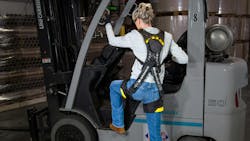Beyond Iron Man: The Real-World Impact of Exoskeletons in the Workplace
Preventing back injuries has been a hot topic within the modern workplace. Up to 80% of Americans experience back pain in their lifetime—the leading cause of disability in 160 countries. In materials handling industries, repetitive bending and lifting put tremendous strain on workers' backs, resulting in back injury rates that far exceed those in the general public and other industries.
Back injuries can be devastatingly painful and often impact a person's quality of life for years, not to mention the economic impact on the companies. For years, workers and companies have assumed (or sometimes been told), "That's just the nature of the job." But it doesn’t have to be.
The need to address safety in the material handling industry is growing. The trend of automation that has been so powerful over recent years can decrease major injuries but has been found to increase the incidence of repetitive stress ergonomic injuries. New ergonomic innovations are being created and implemented to support workers in physical jobs and to help offset increased work pace and higher demands on workers that sometimes come with automation.
Exoskeletons, which are a kind of wearable assistive technology, are advancing at a rapid pace. Five years ago, the focus was on academic studies and industry pilots evaluating the effectiveness of exoskeletons in reducing muscle activity, back strain, and leading indicators of injury risk. Now, there are growing accounts of larger exoskeleton deployments in the industry and new studies shining a light on the economic impact and the longitudinal impacts on injuries and operations.
Hollywood vs. What to Expect From Real-Life Exoskeletons
The term exoskeleton may call up thoughts of futuristic superheroes like Iron Man, or an association with heavy, bulky, rigid machinery worn on the body. In reality, most modern exoskeletons in industry are lightweight, low profile, and flexible. A subclass of exoskeleton called an exosuit even includes solutions made primarily of elastic, flexible textiles. Many of these exosuits resemble safety harnesses or small backpacks and weigh less than a pair of work boots.
Adopting ergonomic solutions in the workplace can significantly improve worker quality of life and productivity, based on worker-reported surveys and dozens of industry field studies. Exoskeletons act like an extra set of muscles to mitigate musculoskeletal loading, such as the repetitive strain that leads to back pain.
While some exoskeletons are powered by motors and batteries, most use elastic bands or springs to assist specific parts of the body. Both classes of exoskeletons can provide substantial back relief during bending and lifting.
A key aspect of exoskeleton design is ensuring freedom of movement and comfort for workers who need to move quickly and operate equipment such as forklifts. This is part of the reason that the exoskeleton field has seen a recent shift towards lighter and softer devices like exosuits.
One leading ergonomics researcher, Dr. Maury Nussbaum of Virginia Tech, remarked in a recent keynote presentation on exoskeletons that "the future of exoskeletons is soft." He also noted that many workers he interacted with and studied in construction, mining, and other sectors have a clear message that they are more receptive to softer materials due to lasting comfort. Focusing on the users' priorities and daily tasks is important in designing and choosing devices.
The Urgent Need for New Safety Innovations
The U.S. Government Accountability Office (GAO) published a recent report calling on the Occupational Safety and Health Administration (OSHA) to take steps to better identify and address ergonomic hazards in warehouses. The report outlined that the most common injuries in the workplace are from overexertion, causing musculoskeletal disorders (MSDs). Furthermore, the warehousing and logistics sector was found to have the highest rate of injury of any industry.
Back pain accounts for more than 264 million lost workdays in the U.S. Recent scientific and industry studies have found that exoskeletons reduced worker-reported back discomfort by an average of 30%, and reduced fatigue by 40%. Workers who wear exoskeletons while performing repetitive tasks ultimately feel less exhausted at the end of the day, impacting their well-being and quality of life both during and after work.
High injury rates and other labor trends have led thousands of companies to seek out wearable assistive devices as a way to complement their existing ergonomic controls. Now, tens of thousands of exoskeletons are being used in warehouses, distribution centers, and other industries to improve workers' quality of life and decrease back and other bodily strain. If trends continue, exoskeleton users are projected to grow into the millions over the next several years.
Longitudinal Data and the Impact of Exosuits on Injury Incidence
Injuries are most likely to happen in the workplace when workers are overexerted and fatigued. However, many of those injuries are preventable. In a recent longitudinal study, workers in four distribution centers used exosuits regularly and worked for more than 281,000 hours. Those warehouses would have historically seen 10.5 back strain injuries during that time, but the workers using exosuits experienced zero injuries based on safety data shared by their employers.
These findings align with some prior longitudinal data on exoskeletons. For instance, one Toyota factory reported that after implementing shoulder exoskeletons on certain jobs the injuries and associated workers’ compensation costs dropped to zero for three consecutive years. Ford Motor Company also conducted an 18-month study with shoulder exoskeletons and found the number of medical visits amongst the exoskeleton group was 52% lower than the control group. However, more long-term research is still needed and the safety community continues to collect and analyze data from these types of larger-scale, longer-term deployments of exoskeletons.
Exoskeletons are increasingly being implemented at food distribution centers, retail warehouses, manufacturing plants, and even within the military. They are not a replacement for good ergonomic practices, rather exoskeletons are part of a comprehensive ergonomics program.
Within the hierarchy of ergonomic controls, some companies classify exoskeletons as administrative or engineering controls, while others treat them as personal protective equipment or tools. There is growing evidence that exoskeletons, when matched with the right jobs, can provide a strong return on investment, based on a combination of operational metrics, longitudinal injury data, ergonomic risk models, and OSHA cost estimates.
How to Deploy Exosuits for Your Workforce
Change management is important for the overall adoption and success of any new piece of equipment. Training users is an important part of this so that workers understand proper usage, as well as exoskeleton benefits and limitations. Proper fit of exoskeletons is also critical. There's a lot to learn from the history of personal protective equipment—and issues with one-size-fits-most approaches—which emphasizes the importance of wearables having appropriate sizing and adjustability to fit men and women of all different shapes and sizes.
Many people falsely assume exoskeletons must cost tens of thousands of dollars per worker. Admittedly, a few do. But many are closer to $1,000 to $3,000 per worker and can last for multiple years. Coupled with the fact that each injury prevented and every minute of productivity boost has the potential to save thousands of dollars per worker per year, there is a clear line to compelling ROI.
For instance, one recent industry study found that an exosuit increased warehouse worker productivity (cases picked per hour) by an average of 8%, while simultaneously reducing MSD injury incidence and employee turnover. In this study, each exosuit solution—including the device, training, and roll-out support—costs about $1,500 to purchase outright. The measured productivity boost alone equated to estimated returns of about $4,000/worker/year. Reductions in back injuries and turnover were estimated to save another $3,000/worker/year. This example highlights what can happen when the right type of exoskeleton is paired with the right type of job, there is potential for high ROI and a payback period in a matter of months.
Finally, some exoskeleton manufacturers offer per-user subscription (or "Exos As A Service") options that keep initial cost outlay modest. Favorable economics and ROI are important, and rigorous research provides confidence in how exoskeletons affect MSD risks, but no operational metrics or statistics can tell the full story. For that, you have to talk to exoskeleton users.
Before occupational use, many workers had never heard of exoskeletons or were skeptical about trying them on the job. Now, many of these folks are regular exoskeleton users who share feedback like, "It took so much pressure off my joints that it allowed me to do extra activities after work. Before that, I would go home and go to sleep," and, "I can go from work to 'Dad' mode & my back doesn't hurt at all." Giving people a better life outside of the warehouse is a cost that’s hard to quantify, but incredibly rewarding.
Ultimately, determining how to balance what's best for your company and the safety of your workers is one of the most important decisions you can make as a business or safety leader. Fortunately, exoskeletons are emerging as a tool that may empower leaders to help both workers and the bottom line at the same time.
About the Author

Karl Zelik, Ph.D.
Chief Scientific Officer & Co-Founder — HeroWear
Karl Zelik, Ph.D. is an associate professor of mechanical engineering at Vanderbilt University, where he co-directs the Center for Rehabilitation Engineering and Assistive Technology.
Dr. Zelik is co-founder and chief scientific officer of occupational exosuit maker HeroWear. He also serves on the board of the non-profit American Bionics Project, performs biomechanics and wearable technology consulting work via Zelik Biomech, and has contributed to the development of exo industry standards as part of the ASTM F48 committee.
